Donate to IMPACT
Click below for info


• The New Abolitionism
• Quickies
(music reviews)
 • E-Mail Comments
• Archives
• Subscribe to IMPACT
• Where to Find
IMPACT
• Buy IMPACT T-Shirts
• Ordering Back Issues
• Home
|
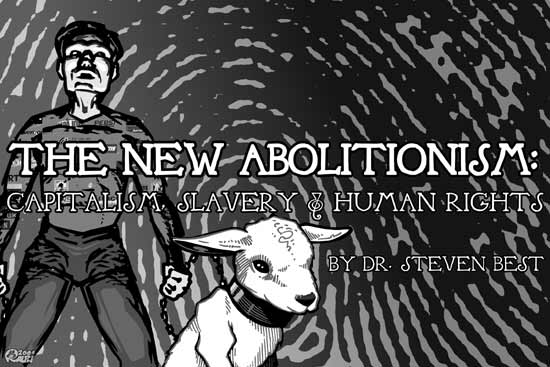
illustrations/W. Ralph Walters
Capitalism originated in, and would have been impossible without, imperialism, colonization, the international slave trade, genocide, and large-scale environmental destruction.
Organized around profit and power imperatives, capitalism is a system of slavery, exploitation, class hierarchy and inequality, violence, and forced labor. The Global Capitalist Gulag was fuelled, first, by the labor power of millions of slaves from Africa and other nations, and, second, by massive armies of immigrant and domestic workers who comprised an utterly new social class, the industrialized proletariat.
As Marx observed, the accumulation of wealth and the production of poverty, the aggrandizement of the ruling class and the immiseration of the ruled, the development of the European world and the underdevelopment of its colonies, are inseparably interrelated. These apparent antipodes are inevitable consequences of a grow-or-die, profit-seeking system of exploitation whose ceaseless expansion requires a slave class and an inordinate amount of cheap labor power.
The transatlantic slave trade began in 1444 when Henry the Navigator began taking Africans back to Portugal to serve as slaves. Africans already were enslaving each other, but their labor market was more akin to indentured servitude and nothing like the horrors they would later face in British America. Prior to trafficking in African slaves, European nations enjoyed positive relationships with Africa based on friendship and trade. This ended in the mid-15th century when they were overtaken by insatiable demands for gold, profits, and slave labor. As evident in the brutal exploits of Columbus and Spain, many European states waged genocidal war against dark-skinned peoples in order to appropriate their land, resources, riches, and labor power.
Over the next few centuries European forces of "civilization," "progress," and Christianity kidnapped twenty million Africans from their homes and villages. They forced inland captives to march 500 grueling miles to the coast while barefoot and in leg irons. Half died before they reached the ships and more expired during the torturous six to ten week journey across the Atlantic to North America. The slave traders confined their human cargo to the suffocating hell beneath the deck. Blacks were packed into tight spaces, chained together, and delirious from heat, stench, and disease. They were beaten, force-fed, and thrown overboard in droves.
Marx rightly saw European colonialism as the "primitive stage of capital development" before the emergence of industrial society. From the 15th to the 19th century, profits from the slave trade built European economies, bankrolled the Industrial Revolution, and powered America before and after the Revolutionary War. The glorious cities and refined cultures of modern Europe were erected on the backs of millions of slaves, its "civilization" the product of barbarism. The horrors of slavery were the burning ethical and political issues of modern capitalism. Over a century after the liberation of blacks in the 1880s, however, slavery has again emerged as a focal point of debate and struggle, as society shifts from considering human to animal slaves and a new abolitionist movement seeking animal liberation emerges as a flashpoint for moral evolution and social transformation.
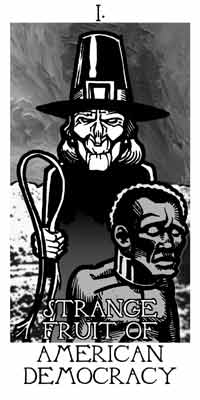 Both before and after the Revolutionary War, America was a slave-hungry system. In its European form, the nation emerged from scratch, with no prior feudal history or communal traditions, a product of British capital ventures. As British colonists found no gold like the Spaniards did in the Americas, they turned to agriculture. From the Indians they learned to grow tobacco as a profitable crop, but planting and harvesting required intense physical labor. For their sturdiness, vulnerability, and cheap price, the colonists favored Africans over Native American Indians and English laborers for the task. Both before and after the Revolutionary War, America was a slave-hungry system. In its European form, the nation emerged from scratch, with no prior feudal history or communal traditions, a product of British capital ventures. As British colonists found no gold like the Spaniards did in the Americas, they turned to agriculture. From the Indians they learned to grow tobacco as a profitable crop, but planting and harvesting required intense physical labor. For their sturdiness, vulnerability, and cheap price, the colonists favored Africans over Native American Indians and English laborers for the task.
The first Africans arrived on the North American continent in August 1619, a year before Pilgrims landed the Mayflower on the shores of Massachusetts and decades before the British slave trade began in New England. Exchanged for food, twenty blacks stepped off a Dutch slavery ship to become the first generation of African Americans. Joining a society not yet lacerated by slavery and racism, they worked as indentured servants to British elites. As such, their status was equal to poor white servants, and servants of either race could gain freedom after their tenure. Like whites, blacks owned property, married, and voted in an integrated society.
This benign situation changed dramatically in the 1660s as ever-more Africans were brought to the colonies to meet the growing need for plantation labor. As slavery became crucial to capitalist expansion and plantation economies organized around tobacco, sugar, and cotton, British colonists constructed racist ideologies to legitimate the violent subjugation of those equal to them in the eyes of God and the principles of natural law. Having survived the shock of capture and wretchedness of their journey, African men, women, and children were auctioned, branded, and sold to white slave owners who grew rich from trading, breeding, and exploiting their bodies. With no consideration of blood ties or emotional bonds, black families were broken apart. Stripped of rights, dignity, and human status, these African citizens and their millions of American descendents were brutalized in the most vicious slavery system on the planet, one whose ugly legacy continues to dominate and poison the U.S.
As colonists became increasingly autonomous from the monarchy abroad, and British military occupation and oppression subsequently increased, the conflict between Empire and its unruly subjects–dramatized in events such as the Boston Tea Party in 1773–inexorably led to war. On July 4, 1776, the Continental Congress adopted the Declaration of Independence which asserted the "self-evident" truth that "all men are created equal" and "are endowed by their Creator with certain inalienable rights." Along with progressive whites such as Thomas Paine and Abigail Adams, slaves were quick to denounce the hypocrisy whereby colonists such as Thomas Jefferson railed against British tyranny while owning slaves drawn from a system far more repressive than English monarchy.
Whereas many blacks fought for the British who promised them freedom, others fought courageously for the patriot cause and were crucial to its victory. When the war ended in 1783, social relations and racial views were in great flux. Tens of thousands of slaves fled to England, Canada, Spanish Florida, or Indian camps. Many Northern slaveholders who embraced the nation's egalitarian values without regard to race freed their captives. In 1783, Massachusetts became the first state to abolish slavery and from 1789 to 1830 all states north of Maryland gradually followed suit. At the same time, however, slavery grew stronger roots in Southern states that were becoming increasingly influential economically and politically.
The new nation stood at a crucial moral crossroads regarding the slavery question and the true meaning of its professed democratic and Christian values. It could end slavery and adhere to its noble ideals, or it could perpetuate a vicious system of bondage to be an American hypocrisy, not democracy. Tragically, the profit imperative triumphed over the moral imperative. Although the North continuously pandered to Southern slavery interests, the two cultures drifted apart irreconcilably like shifting tectonic plates. Rather than pulling together as one nation honoring the progressive values that led them to war, the U.S. imploded through internal contradictions and in 1861 embarked on a bloody war with itself.
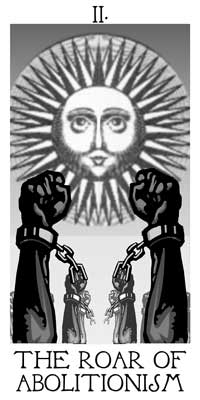 With freedom denied and justice betrayed, both free and enslaved blacks intensified their resistance to white oppression. Increasingly, opponents of slavery turned from tactics of reform and moderation to demands for the total and immediate dismantling of the slavery system, and thus, in the 1830s, the abolitionist movement was born. With freedom denied and justice betrayed, both free and enslaved blacks intensified their resistance to white oppression. Increasingly, opponents of slavery turned from tactics of reform and moderation to demands for the total and immediate dismantling of the slavery system, and thus, in the 1830s, the abolitionist movement was born.
Abolitionism is rooted in a searing critique of racism and its dehumanizing effects on black people. In the U.S. slavery market, a human being, on the basis of skin color alone, was declared biologically and naturally inferior to whites and thereby stripped of all rights. In such a system, the slave is transmogrified from a human subject into a physical object, from a person into a commodity, and thereby reduced to a moveable form of property known as "chattel." Abolitionists viewed the institution of slavery as inherently evil, corrupt, and dehumanizing, such that no black person in bondage–however well-treated by their "masters"–could ever attain the full dignity, intelligence, and creativity of their humanity. Abolitionists renounced all reformist approaches that sought better or more "humane treatment" of slaves, in order to insist on the total emancipation of blacks from the chains, masters, laws, courts, and ideologies that corrupted, stunted, and profaned their humanity.
The most militant abolitionist voices advocated the use of violence as a necessary or legitimate tactic of struggle and self-defense. In 1829, David Walker published his "Appeal to the Colored Citizens of the World," a fiery eighty-page pamphlet excoriating slavery and calling blacks to violent rebellion. Similarly, in his 1843 keynote address to the National Convention of Colored Citizens, Presbyterian minister Henry Highland Garnet enjoined the nationšs three million blacks to demand freedom and strike their oppressors down if necessary, for "there is not much hope of redemption without the shedding of blood."
Along with the Haitian Revolution of August 22, 1791, whereby black slaves violently overthrew Spanish and British occupiers to establish Haiti as a free black republic, such views panicked U.S. slave owners over the possibility of slave revolts and violence. Their fears were justified, as blacks throughout the country were plotting and carrying out rebellions, achieving with bullets, machetes, or fire the justice denied to them in the courts. Whereas rebels such as Gabriel Prosser and Denmark Vesey were betrayed and executed before they could ignite large-scale insurrections, others like Nat Turner and John Brown (a white Christian) spilled the blood of many slave owners before being captured and executed by the state, and resurrected as folk heroes by the enemies of slavery.
Other influential voices urged militancy and direct action without violence. William Lloyd Garrison, a former indentured white servant, started a prominent abolitionist newsletter, the Liberator, on January 1, 1831, which he published for 35 years. Against those urging slow, gradual, and moderate change, Garrison objected: "I do not wish to think, to speak, or write, with moderation... Tell a man whose house is on fire to give a moderate alarm; tell him to moderately rescue his wife from the hands of the ravisher; tell the mother to gradually extricate her babe from the fire into which it has fallen; but urge me not to use moderation in a cause like the present!"
Garrison also brought Frederick Douglass into the abolitionist movement. Douglass was born into slavery, became self-educated, and fled from bondage. With Garrisonšs initial assistance, he became a star on the lecture circuit and in 1848 began publishing his own abolitionist newspaper, the North Star. In his electrifying speeches, Douglass preached a potent "gospel of struggle," most eloquently expressed in an 1857 speech that exposed the Machiavellian essence of politics: "Power concedes nothing without a demand. It never did and never will... The whole history of the progress of human liberty shows that all concessions yet made to her august claims have been born of earnest struggle... If there is no struggle there is no progress. Those who profess to favor freedom and yet deprecate agitation, are men who want crops without plowing up the ground, they want rain without thunder and lightning. They want the ocean without the awful roar of its waters."
A vital part of the abolitionist movement was the Underground Railroad, a furtive, illegal network of volunteers–white and black, male and female, free person and slave–who violated pro-slavery laws in order to smuggle thousands of slaves into northern free states and Canada. Harriet Tubman not only was a "passenger" on the railroad, using it to escape slavery in 1849 at age 25, she also became its celebrated "Conductor." Risking jail or death, dodging slave hunters out for the $40,000 bounty on her head, Tubman returned to Maryland numerous times to free family members and seventy other slaves. She epitomizes the courage, passion for freedom, and acute sense of justice driving the abolitionist movement.
After the Civil War ended in 1865, Congress passed the 13th, 14th, and 15th Amendments, thereby banning slavery and mandating equal treatment for blacks and whites. By the late 1880s, blacks throughout the nation were formally "free," but in reality, they remained trapped in systems of racist hatred, violence, exploitation, and poverty. Despite advances during the brief Reconstruction Period, America reconstituted racist discrimination in frightful new ways. As the U.S. became an apartheid system organized around Jim Crow segregation laws, violence against blacks increased dramatically through lynch mobs and the Ku Klux Klan. Not until the civil rights struggles of the 1950s and 1960s and the Civil Rights Act of 1964 did brutality diminish, the walls of apartheid come down, and significant social progress become possible.
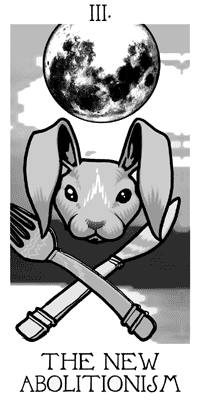 As black Americans and anti-racists continue to struggle for justice and equality, the moral and political spotlight is shifting to a far more ancient, pervasive, intensive, and violent form of slavery that confines, tortures, and kills animals by the billions in an ongoing global holocaust. As black Americans and anti-racists continue to struggle for justice and equality, the moral and political spotlight is shifting to a far more ancient, pervasive, intensive, and violent form of slavery that confines, tortures, and kills animals by the billions in an ongoing global holocaust.
We speak of animal liberation no differently than human liberation. One cannot "enslave," "dominate," or "exploit" physical objects, nor can they be "freed," "liberated," or "emancipated." These terms apply only to organic life forms that are sentient–to beings who can experience pleasure and pain, happiness or suffering. Quite apart from species differences and arbitrary attempts to privilege human powers of reason and language over the unique qualities of animal life, human and nonhuman animals share the same evolutionary capacities for joy or suffering, and in this respect they are essentially the same or equal.
Fundamentally, ethics demands that one not cause suffering to another being or impede another's freedom and quality of life, unless there is some valid, compelling reason to do so (e.g., self-defense). For all the voluminous scientific literature on the complexity of animal emotions, intelligence, and social life, a being's capacity of sentience is a necessary and sufficient condition for having basic rights.
Thus, just as animals can be enslaved, so too can they be liberated; indeed, where animals are enslaved, humans arguably have a duty to liberate them. Answering this call of conscience and duty, animal liberation groups have sprouted throughout the world with the objectives of freeing captive animals from systems of exploitation, attacking and dismantling the economic and material basis of oppression, and challenging the ancient mentality that animals exist as human resources, property, or chattel.
Stealing blacks from their native environment and homeland, wrapping chains around their bodies, shipping them in cramped quarters across continents for weeks or months with no regard for their suffering, branding their skin with a hot iron to mark them as property, auctioning them as servants, separating family members who scream in anguish, breeding them for service and labor, exploiting them for profit, beating them in rages of hatred and anger, and killing them in huge numbers–all these horrors and countless others inflicted on black slaves began with the exploitation of animals. Advanced by technology and propelled by capitalist profit imperatives, the unspeakably violent violation of animals'emotions, minds, and bodies continues today with the torture and killing of billions of individuals in fur farms, factory farms, slaughterhouses, research laboratories, and other nightmarish settings.
It is time no longer just to question the crime of treating a black person or any other human victim of violence "like an animal"; rather, we must also scrutinize the unquestioned but more fundamental wrong of exploiting and terrorizing animals.
Whereas the racist mindset creates a hierarchy of superior/inferior on the basis of skin color, the speciesist mindset demeans and objectifies animals by dichotomizing the evolutionary continuum into human and nonhuman life. As racism stems from a hateful white supremacism, so speciesism draws from a violent human supremacism, namely, the arrogant belief that humans have a natural or God-given right to use animals for any purpose they devise.
Both racism and speciesism serve as legitimating ideologies for slavery economies. After the civil war, the Cotton Economy became the Cattle Economy as the nation moved westward, slaughtered millions of Indians and buffalo, and began intensive operations to raise and slaughter cattle for food. Throughout the twentieth century, as the U.S. shifted from a plant-based to a meat-based diet, meat and dairy industries became giant economic forces. In the last few decades, pharmaceutical and biotechnology companies have become major components of global capitalist networks, and their research and testing operations are rooted in the breeding, exploitation, and killing of millions of laboratory animals each year
Of course, as soon as Homo erectus began making tools nearly three million years ago, hominids have killed and appropriated animals for labor power, food, clothing, and innumerable other resources, and animal exploitation has been crucial to human economies. But whatever legitimate reasons humans had for using animals to survive in past hunting and gathering societies, subsistence economies, and other low-tech cultures, these rationales are now obsolete in a modern world rife with alternatives to using animals for food, clothing, and medical research. Furthermore, however important the exploitation of animals might be to modern economies, utilitarian apologies for enslaving animals are as invalid as arguments used to justify human slavery or experimentation on human beings at Auschwitz or Tuskegee. Rights trump utilitarian appeals; their very function is to protect individuals from being appropriated for someone elsešs or a "greater good."
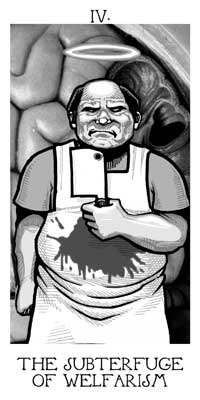 It was not uncommon for a racist to argue that slavery was beneficial for blacks or that they were biologically unfit for freedom. Similarly, factory farm managers claim that pigs, calves, and chickens are better off in conditions of intense confinement rather than in their natural habitat as their "needs are met" in "managed environments." Zookeepers and circus operators assert that their animals live better in confinement that in the wild where they are subject to poachers and other dangers. It was not uncommon for a racist to argue that slavery was beneficial for blacks or that they were biologically unfit for freedom. Similarly, factory farm managers claim that pigs, calves, and chickens are better off in conditions of intense confinement rather than in their natural habitat as their "needs are met" in "managed environments." Zookeepers and circus operators assert that their animals live better in confinement that in the wild where they are subject to poachers and other dangers.
Abolitionists attack welfarism as a dangerous ruse and roadblock to moral progress, and ground their position in the logic of rights. Nineteenth century abolitionists were not addressing the slave master's "obligation" to be kind to the slaves, to feed and clothe them well, to allow them on occasion to read, and to work them with adequate rest. Rather, they demanded the total and unqualified eradication of the master-slave relation, the freeing of the slave from all forms of bondage.
Similarly, the new abolitionists reject reforms of the institutions and practices of animal slavery as grossly inadequate and they pursue the complete emancipation of animals from all forms of human exploitation, subjugation, and domination. They seek not bigger cages, but rather empty cages.
To treat black slaves humanely is a contradiction in terms because the institution of slavery inherently is anti-human and dehumanizing. Similarly, one cannot logically be "kind" to animals kept in debilitating confinement against their will. To "act responsibly" to animals in such a situation requires one to liberate them from it. Talk of "humane killing"of animals is especially absurd as there is no "humane" way to steal and violate an animal's life. No accurately aimed bolt shot through the head of an animal warrants pretense to any kind of moral dignity, however superior the killing method is to dismemberment of an animal in a conscious state. Killing–unnecessary and unjustified–is, in itself, inhumane and wrong.
While thousands of national and grass-roots animal welfare organizations help animals in countless ways and reduce their suffering, they cannot free them from exploitation. Welfarists never challenge the legitimacy of institutions of oppression and they share with animal exploiters the speciesist belief that humans have a right to use animals as resources as long as they act "responsibly." Moral progress and animal liberation is premised on making the profound shift from human responsibility to animals to the rights of animals.
The true obstacles to moral progress are not the sociopaths who burn cats alive, for they are an extreme minority whose actions are almost universally condemned as barbaric. The real barrier to animal liberation is the welfarist orientation and its language of "humane care," "responsible treatment," and "kindness and respect." Every institution of animal exploitation–including the fur farm and slaughterhouse industries–speaks this language, and animals in their "care" are routinely tortured in horrific ways. Animal welfarism is insidious. It lulls people into thinking that animals in captivity are healthy and content. It promotes human supremacy and tries to dress up the fundamental wrong of exploiting animals in the illusory language of "kind," "respectful," and "humane" treatment. Attempting to mask and sanitize the evil of oppression, animal welfarism perverts language, corrupts meaning, and is fundamentally Orwellian and deceptive.
Furthermore, by trying to hijack and monopolize the discourse of moral responsibility solely for its own purposes as it feigns ethical behavior, animal welfarism strategically positions animal rights discourse of any kind–because of the premise that animals are not our resources to use–as extreme. And if an animal rights advocate or organization transgresses conservative decorum or legal boundaries in any way, welfarists denounce the tactics as "violent" and "terrorist," as measures that "discredit" an otherwise respectable concern for animal welfare.
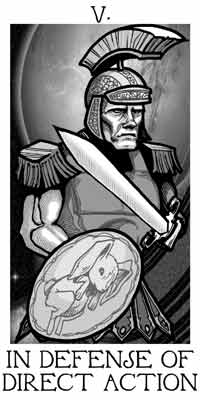 Although abolitionism is rooted in the logic of rights, not welfarism, there are problems with some animal rights positions that also must be overcome. First, as emphasized by law professor Gary Francione, many individuals and organizations that champion animal rights in fact are "new welfarists"who speak in terms of rights but in practice seek welfare reforms and thereby seek to ameliorate, not abolish, oppression. While Francione underplays the complex relationship between welfare and rights, reform and abolition, he illuminates the problem of obscuring fundamental differences between welfare and rights approaches and he correctly insists on the need for uncompromising abolitionist campaigns. Although abolitionism is rooted in the logic of rights, not welfarism, there are problems with some animal rights positions that also must be overcome. First, as emphasized by law professor Gary Francione, many individuals and organizations that champion animal rights in fact are "new welfarists"who speak in terms of rights but in practice seek welfare reforms and thereby seek to ameliorate, not abolish, oppression. While Francione underplays the complex relationship between welfare and rights, reform and abolition, he illuminates the problem of obscuring fundamental differences between welfare and rights approaches and he correctly insists on the need for uncompromising abolitionist campaigns.
Francione, however, is symptomatic of a second problem with animal rights "legalists" who buy into the status quo's self-serving argument that the only viable and ethically acceptable tactics for a moral or political cause are those the state pre-approves and sanctions. In rejecting the militant direct action tactics that played crucial roles throughout the struggles to end both human and animal slavery, Francione and others use the same rationale animal welfarists employ against them. Mirroring welfare critiques of rights, and serving as a mouthpiece for the state and animal exploitation industries, Francione criticizes direct activists as radical, extreme, and damaging to the moral credibility and advancement of the cause.
Like its predecessor, the new abolitionist movement is diverse in its philosophy and tactics, ranging from legal to illegal approaches and pacifist to violent orientations. A paradigmatic example of the new abolitionism is the Animal Liberation Front (ALF). The ALF advocates illegal direct action tactics against animal slave owners; however, because they define violence only as harm to living beings and not objects, ALF activists eschew the violence espoused by Walker and Garnet. Operating through underground cell structure, the ALF seeks to eliminate or weaken exploitation industries through intimidation and property destruction. In direct and immediate acts of liberation, the ALF breaks into prison compounds to release or rescue animals from their cages. By providing veterinary treatment and homes for many of the animals they liberate, using an extensive underground network of care and home providers, the ALF is a superb contemporary example of the Underground Railroad.
The new abolitionism also is evident in the work of "open rescue"groups like Compassion Over Killing, who liberate animals from factory farms without causing property destruction or hiding behind masks of anonymity. Moreover, ethical vegans who boycott all animal products for the principle reason that it is wrong to use or kill animals as food resources–however "free-range" or "humanely" produced or killed–abolish cruelty from their lives and contribute toward eliminating animal exploitation altogether.
As of yet, there are no active Nat Turners and John Browns in the animal liberation movement, but they may be forthcoming and would not be without just cause for their actions. Nor would they be without precedent. According to the gospel of struggle: No justice, no peace.
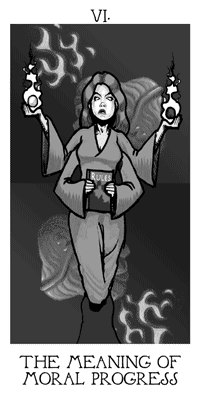 Just as 19th century abolitionists sought to awaken people to the greatest moral issue of the day, so the new abolitionists of the 21st century endeavor to enlighten people about the enormity and importance of animal suffering and oppression. As black slavery earlier raised fundamental questions about the meaning of American "democracy"and modern values, so current discussion regarding animal slavery provokes critical examination into a human psyche damaged by violence, arrogance, and alienation, and the urgent need for a new ethics and sensibility rooted in respect for all life. Just as 19th century abolitionists sought to awaken people to the greatest moral issue of the day, so the new abolitionists of the 21st century endeavor to enlighten people about the enormity and importance of animal suffering and oppression. As black slavery earlier raised fundamental questions about the meaning of American "democracy"and modern values, so current discussion regarding animal slavery provokes critical examination into a human psyche damaged by violence, arrogance, and alienation, and the urgent need for a new ethics and sensibility rooted in respect for all life.
Animal liberation is not an alien concept to modern culture; rather it builds on the most progressive ethical and political values Westerners have devised in the last two hundred years–those of equality, democracy, and rights–as it carries them to their logical conclusions. Whereas ethicists such as Arthur Kaplan argue that rights are cheapened when extended to animals, it is far more accurate to see this move as the redemption of rights from an arbitrary and prejudicial limitation of their true meaning.
The next great step in moral evolution is to abolish the last acceptable form of slavery that subjugates the vast majority of species on this planet to the violent whim of one. True moral advance involves sending human supremacy to the same refuse bin that society earlier discarded much male supremacy and white supremacy. Animal liberation requires that people transcend the complacent boundaries of humanism in order to make a qualitative leap in ethical consideration, thereby moving the moral bar from reason and language to sentience and subjectivity.
Animal liberation is the culmination of a vast historical learning process whereby human beings gradually realize that arguments justifying hierarchy, inequality, and discrimination of any kind are prejudiced, baseless, and fallacious. Moral progress occurs in the process of demystifying and deconstructing all myths–from ancient patriarchy and the divine right of kings to Social Darwinism and speciesism–that attempt to legitimate the domination of one group over another. Moral progress advances through the dynamic of replacing hierarchical visions with egalitarian visions and developing a broader and more inclusive ethical community. Having recognized the illogical and unjustifiable rationales used to oppress blacks, women, and other disadvantaged groups, society is beginning to grasp that speciesism is another unsubstantiated form of oppression and discrimination.
Building on the momentum, consciousness, and achievements of past abolitionists and suffragettes, the struggle of the new abolitionists might conceivably culminate in a Bill of (Animal) Rights. This would involve a constitutional amendment that bans exploitation of animals and discrimination based on species, recognizes animals as "persons" in a substantive sense, and grants them the rights relevant and necessary to their existence–the rights to life, liberty, and the pursuit of happiness. In 2002, Germany took the crucial first step in this direction by adding the words "and animals" to a clause in its constitution obliging the state to protect the dignity of humans.
If capitalism is a grow-or-die system based on slavery and exploitation–be it imperialism and colonialism, exploitation of workers, unequal pay based on gender, or the oppression of animals–then it is a system that a movement for radical democracy must transcend, not amend. But just as black slaves condemned the hypocrisy of colonists decrying British tyranny, and suffragettes exposed the contradiction of the U.S. fighting for democracy abroad during World War I while denying it to half of their citizenry at home, so any future movement for peace, justice, democracy, and rights that fails to militate for the liberation of animals is as inconsistent as it is incomplete.
•
Dr. Steven Best's new book, co-edited with Anthony J. Nocella, Terrorists or Freedom Fighters: Reflections on the Liberation of Animals is available from Lantern Books. It features leading eco-terrorists like Paul Watson, Rod Coronado, Kevin Jones, and Ingrid Newkirk.
Email your feedback on this article to editor@impactpress.com.
Make an IMPACT
Other articles by Dr. Steven Best:
|




 Both before and after the Revolutionary War, America was a slave-hungry system. In its European form, the nation emerged from scratch, with no prior feudal history or communal traditions, a product of British capital ventures. As British colonists found no gold like the Spaniards did in the Americas, they turned to agriculture. From the Indians they learned to grow tobacco as a profitable crop, but planting and harvesting required intense physical labor. For their sturdiness, vulnerability, and cheap price, the colonists favored Africans over Native American Indians and English laborers for the task.
Both before and after the Revolutionary War, America was a slave-hungry system. In its European form, the nation emerged from scratch, with no prior feudal history or communal traditions, a product of British capital ventures. As British colonists found no gold like the Spaniards did in the Americas, they turned to agriculture. From the Indians they learned to grow tobacco as a profitable crop, but planting and harvesting required intense physical labor. For their sturdiness, vulnerability, and cheap price, the colonists favored Africans over Native American Indians and English laborers for the task.
 With freedom denied and justice betrayed, both free and enslaved blacks intensified their resistance to white oppression. Increasingly, opponents of slavery turned from tactics of reform and moderation to demands for the total and immediate dismantling of the slavery system, and thus, in the 1830s, the abolitionist movement was born.
With freedom denied and justice betrayed, both free and enslaved blacks intensified their resistance to white oppression. Increasingly, opponents of slavery turned from tactics of reform and moderation to demands for the total and immediate dismantling of the slavery system, and thus, in the 1830s, the abolitionist movement was born.
 As black Americans and anti-racists continue to struggle for justice and equality, the moral and political spotlight is shifting to a far more ancient, pervasive, intensive, and violent form of slavery that confines, tortures, and kills animals by the billions in an ongoing global holocaust.
As black Americans and anti-racists continue to struggle for justice and equality, the moral and political spotlight is shifting to a far more ancient, pervasive, intensive, and violent form of slavery that confines, tortures, and kills animals by the billions in an ongoing global holocaust.
 It was not uncommon for a racist to argue that slavery was beneficial for blacks or that they were biologically unfit for freedom. Similarly, factory farm managers claim that pigs, calves, and chickens are better off in conditions of intense confinement rather than in their natural habitat as their "needs are met" in "managed environments." Zookeepers and circus operators assert that their animals live better in confinement that in the wild where they are subject to poachers and other dangers.
It was not uncommon for a racist to argue that slavery was beneficial for blacks or that they were biologically unfit for freedom. Similarly, factory farm managers claim that pigs, calves, and chickens are better off in conditions of intense confinement rather than in their natural habitat as their "needs are met" in "managed environments." Zookeepers and circus operators assert that their animals live better in confinement that in the wild where they are subject to poachers and other dangers.
 Although abolitionism is rooted in the logic of rights, not welfarism, there are problems with some animal rights positions that also must be overcome. First, as emphasized by law professor Gary Francione, many individuals and organizations that champion animal rights in fact are "new welfarists"who speak in terms of rights but in practice seek welfare reforms and thereby seek to ameliorate, not abolish, oppression. While Francione underplays the complex relationship between welfare and rights, reform and abolition, he illuminates the problem of obscuring fundamental differences between welfare and rights approaches and he correctly insists on the need for uncompromising abolitionist campaigns.
Although abolitionism is rooted in the logic of rights, not welfarism, there are problems with some animal rights positions that also must be overcome. First, as emphasized by law professor Gary Francione, many individuals and organizations that champion animal rights in fact are "new welfarists"who speak in terms of rights but in practice seek welfare reforms and thereby seek to ameliorate, not abolish, oppression. While Francione underplays the complex relationship between welfare and rights, reform and abolition, he illuminates the problem of obscuring fundamental differences between welfare and rights approaches and he correctly insists on the need for uncompromising abolitionist campaigns.
 Just as 19th century abolitionists sought to awaken people to the greatest moral issue of the day, so the new abolitionists of the 21st century endeavor to enlighten people about the enormity and importance of animal suffering and oppression. As black slavery earlier raised fundamental questions about the meaning of American "democracy"and modern values, so current discussion regarding animal slavery provokes critical examination into a human psyche damaged by violence, arrogance, and alienation, and the urgent need for a new ethics and sensibility rooted in respect for all life.
Just as 19th century abolitionists sought to awaken people to the greatest moral issue of the day, so the new abolitionists of the 21st century endeavor to enlighten people about the enormity and importance of animal suffering and oppression. As black slavery earlier raised fundamental questions about the meaning of American "democracy"and modern values, so current discussion regarding animal slavery provokes critical examination into a human psyche damaged by violence, arrogance, and alienation, and the urgent need for a new ethics and sensibility rooted in respect for all life.